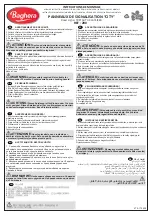
Page
aDJUSTINg ThE braKE lINKagE
With the transmitter and receiver turned on, and the throttle trim and the servo arm centred, the XT2 should roll forward smoothly when
pushed (i.e., the brakes should be disengaged). If the brakes are dragging when the
throttle trigger is at neutral, the brake discs will wear out very quickly. To ensure that
the brakes are disengaged, always make sure that there is a 1/16" (1mm) wide gap
between the two rear collars and the brake levers. Both collars should be adjusted so
that they are equal distance behind each of the two brake levers. This will ensure that
both brake levers engage equally during braking.
❑
To make adjustments to the brake linkage, simply loosen the grub screw in the collars
behind the brake levers and reposition them, then retighten the grub screws.
moving
the collars forward, toward the brake levers, will result in the brakes coming on
sooner and more forcefully.
aDJUSTINg ThE braKE bIaS
Since the front and rear brakes can be adjusted independently of each other, you may not want both front and rear brakes to engage
at the same time. If you want the rear brakes to engage just before the front brakes, move the collar at the front brake lever just a
fraction further back from neutral. This will result in the back brakes engaging just before the front brakes. If you want the front brakes
to engage just before the rear brakes, move the collar at the rear brake lever just a fraction further back from neutral. This will result
in the front brakes engaging just before the back brakes. Experimentation will be necessary to achieve the desired braking response,
dependant on your track conditions and driving style.
By adjusting the spring tension of the shocks, you can increase steering sensitivity, adjust the ride-height of the xT2 and fine-tune the
dampening quality of the suspension system. How you drive your XT2 will dictate what settings you should be using. As an example,
if you're driving your XT2 off-road and going over lots of jumps, you may want to increase the spring tension of the front shocks to help
prevent the front of the XT2 from bottoming out. If you're racing your XT2, local track conditions will dictate the settings to use.
●
We recommend initially leaving the factory-installed preload clips on the shocks.
❑
Increase or decrease spring tension by installing different thickness shock preload
clips. Using taller preload clips increases spring tension and the chassis ride height,
and will stiffen the overall dampening characteristics of the suspension. Using shorter
preload clips decreases spring tension and makes the dampening characteristics of the
suspension softer.
+
When adjusting the spring tension, make sure to adjust both shocks on the right and left
sides equally.
aDJUSTINg ShocK SprINg TENSIoN
reCommenDeD initiaL settings
Shock springs are easy to change and can make a difference in the way your XT2 handles relative to the type of terrain you're driving
on. If you drive your XT2 off-road, in a smooth, high-traction area, use stiffer springs to reduce body roll and weight shift. If the area
where you drive your XT2 is very bumpy, you might consider using softer springs to help absorb the bumps. If the area is bumpy and
you use harder springs, the XT2 will have a tendency to jump and hop around. The shock springs included with the XT2 are suitable
for most general off-road applications.
58mm and 80.5mm 1.3mm Shock Spring (RED)
58mm and 80.5mm 1.4mm Shock Spring (BLUE)
58mm and 80.5mm
1.5mm shock spring (WHite) - stoCK
58mm and 80.5mm 1.6mm Shock Spring (YELLOW)
58mm and 80.5mm 1.7mm Shock Spring (BLACK)
Front and rear
sHoCK springs
soFt
stiFF
















































